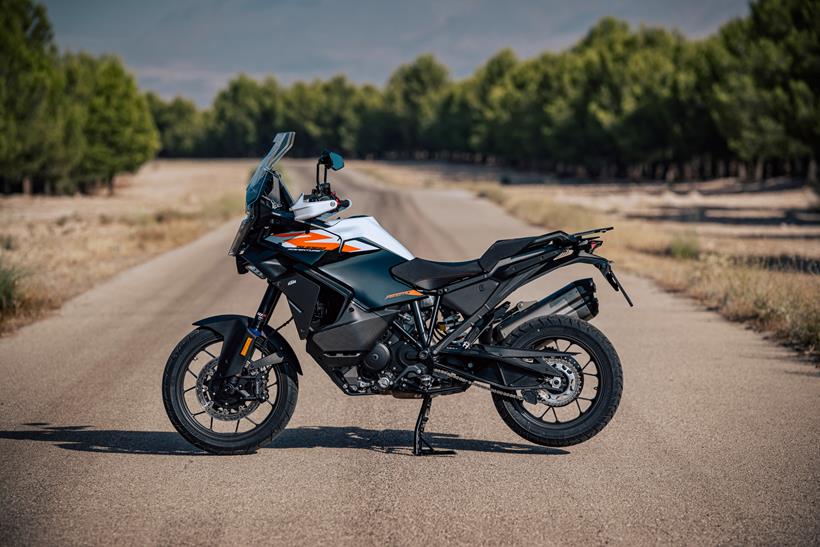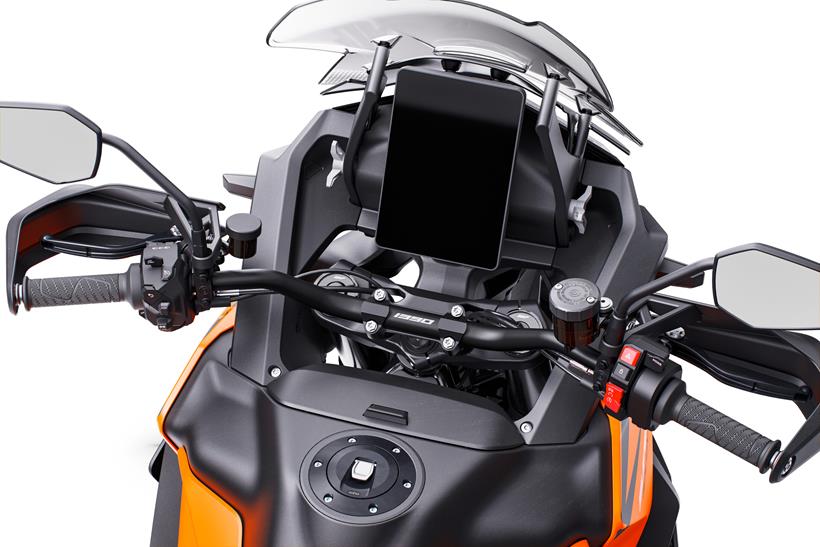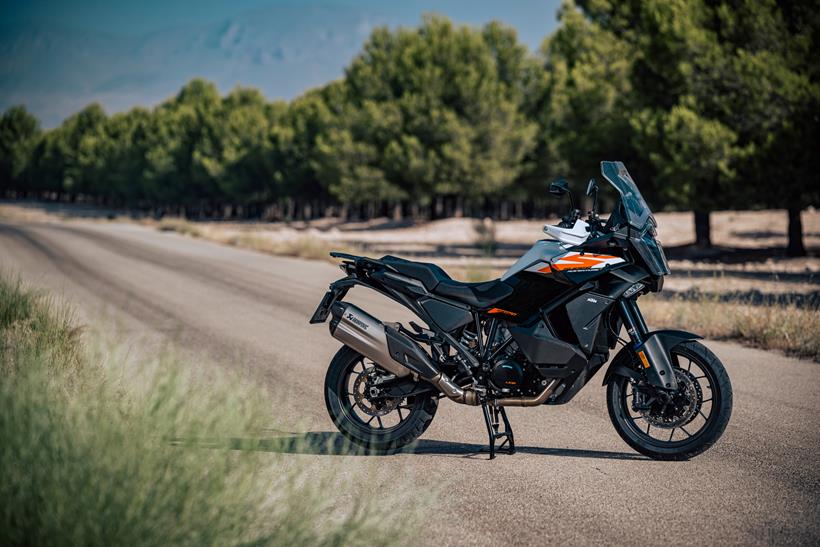Purists rejoice! Manual version of KTM's incoming 1390 Super Adventure S confirmed featuring 170bhp
KTM Super Adventure S: A Manual Transmission Option
KTM has released a new iteration of their 2025 1390 Super Adventure S, this time featuring a traditional manual gearbox. This addition is a significant departure from the model's usual automatic transmission, offering riders a more engaging and direct riding experience.
Technical Specifications:
- Engine: 1390cc V-twin, producing over 180 horsepower
- Transmission: 6-speed manual gearbox
- Suspension: WP Apex fully adjustable front and rear suspension
- Brakes: Brembo Stylema monobloc calipers
- Electronics: Cornering ABS, traction control, cruise control, and rider modes
Pros and Cons:
Pros:
- Enhanced Driver Engagement: The manual gearbox offers a more active and rewarding riding experience, allowing riders to control gear shifts directly.
- Improved Throttle Response: Manual transmissions often provide a more immediate and precise throttle response compared to automatics.
- Potential for Improved Fuel Economy: Manual gearboxes can offer better fuel efficiency due to the ability to optimize gear selection.
Cons:
- Increased Complexity: Manual transmissions require more driver input and coordination, making them potentially more challenging for beginners.
- Limited Convenience: Manual transmissions may not be as convenient for city riding or in stop-and-go traffic.
Key Takeaways:
- The introduction of a manual gearbox provides a welcome alternative for riders who prefer the engagement and control of a manual transmission.
- This addition caters to experienced riders seeking a more visceral and rewarding riding experience.
Related: Bosch launch six new radar cruise features with KTM
Super Adventure S vs. Super Adventure S Evo: A Detailed Comparison
The KTM Super Adventure S Evo, unveiled recently, boasts a semi-automatic AMT gearbox, a feature absent in its predecessor, the Super Adventure S. However, both bikes share many fundamental features.
Key Shared Features
- Engine: Both models feature a powerful 1,050cc liquid-cooled, V-twin engine, generating around 120 hp and 109 Nm of torque.
- Suspension: Both bikes offer adjustable WP suspension, providing exceptional on and off-road performance.
- Electronics: Both utilize a comprehensive suite of electronics, including multiple riding modes, traction control, and ABS.
- Ergonomics: Both bikes feature comfortable rider ergonomics with adjustable handlebars and windshields.
Differentiating Feature: AMT Gearbox
The Super Adventure S Evo differentiates itself with its KTM AMT gearbox.
How it works:
- The AMT gearbox uses a traditional manual transmission but introduces a hydraulic actuator to engage the clutch and shift gears automatically.
- The rider can choose between automatic and manual modes via a thumb-operated switch.
- The system utilizes a sophisticated sensor network to optimize gear selection based on speed, throttle input, and other factors.
Pros:
- Improved comfort: Reduced clutch effort and smoother gear changes enhance rider comfort, especially during long rides.
- Easier riding: The automatic mode simplifies riding, ideal for beginners or those who prefer a more relaxed experience.
- Improved fuel efficiency: The system optimizes gear selection for optimal fuel consumption.
Cons:
- Less control: The rider has less control over gear selection compared to a manual gearbox.
- Potentially slower shifts: While smoother, the shifts can be slightly slower than manual.
Real-world Applications
The Super Adventure S Evo, with its AMT gearbox, is an excellent option for adventure riders seeking a more relaxed and user-friendly experience. It enhances comfort during long journeys and simplifies riding, particularly in demanding off-road conditions.
Important Notes:
- The Super Adventure S remains a compelling option for riders who prefer complete control over gear selection and a more traditional riding experience.
- The AMT gearbox is a relatively new technology in the motorcycle world, and its long-term durability and reliability are yet to be fully established.
Like the Evo, the manual S model will replace the outgoing 1290 Super Adventure S
The KTM 1290 Super Adventure S: A New Era of Adventure
The KTM 1290 Super Adventure S has undergone a significant transformation, with the manual "S" model replacing its predecessor and boasting several key improvements.
Engine Capacity and Emissions Compliance
- Engine: The new model features a larger 1,350cc engine, a significant increase from the previous 1,301cc unit. This larger displacement not only enhances power output but also plays a crucial role in meeting the stringent Euro 5+ emissions regulations.
- Emissions: The Euro 5+ standard mandates stricter limits on harmful emissions, including hydrocarbons, carbon monoxide, and nitrogen oxides. The larger engine and optimized engine management system allow the KTM 1290 Super Adventure S to meet these regulations while maintaining its impressive performance.
Key Takeaways
- The larger engine provides increased power and torque for an even more exhilarating riding experience.
- The model's commitment to environmental responsibility is reinforced by its adherence to the Euro 5+ emissions standards.
Comparison with the KTM 1290 Super Adventure Evo
The KTM 1290 Super Adventure S and the KTM 1290 Super Adventure Evo are both high-performance adventure motorcycles, but they cater to different rider preferences:
- S model: Designed for a more agile and sporty riding experience with a manual transmission.
- Evo model: Offers a more comfortable and touring-focused approach with advanced electronic rider aids and a semi-active suspension system.
The choice between the two models depends on your intended use and riding style.
It sits at the more road-focussed end of the adventure segment

Wheel Size and Off-Road Capability
This motorcycle, positioned towards the road-oriented end of the adventure segment, features a unique wheel setup: 19-inch front and 17-inch rear cast wheels.
Technical Specifications:
- Front Wheel: 19 inches, cast
- Rear Wheel: 17 inches, cast
Key Takeaways:
- Road-focused performance: Larger front wheels (19 inches) provide stability and precise handling on paved roads, contributing to a comfortable ride.
- Off-road capability: While not optimized for hardcore off-roading, the 17-inch rear wheel offers a decent balance between comfort and traction on unpaved surfaces.
- Cast wheels: Cast wheels are known for their strength and durability, making them suitable for both road and occasional off-road use.
Pros:
- Enhanced handling and comfort on paved roads
- Improved stability at higher speeds
- Durable and reliable wheels
Cons:
- Limited off-road performance compared to motorcycles with larger, spoked wheels
- Greater weight compared to spoked wheels
Comparison to Similar Technologies:
- Larger, spoked wheels: Often found on more hardcore adventure motorcycles, these offer greater off-road capability due to their flexibility and ability to handle rough terrain. However, they are heavier and less durable than cast wheels.
- Smaller wheels: Found on street bikes, these offer agility and responsiveness but lack the stability and comfort of larger wheels.
Real-world Applications:
This wheel setup makes the motorcycle suitable for long-distance touring, commutes, and occasional off-road adventures. It caters to riders who prioritize road performance but still want the versatility of an adventure bike for exploring unpaved roads.
This motor is paired with a traditional six-speed gearbox and clutch lever
Powertrain: A Blend of Tradition and Performance
This motorcycle features a powerful engine paired with a traditional six-speed gearbox and a manual clutch lever. The engine produces a claimed 170.6bhp at 9500rpm and a torque figure of 107lb.ft at 8000rpm. This impressive power output positions it as a direct competitor to the Ducati Multistrada V4S (170bhp) and the BMW S1000XR (168bhp).
Key Takeaways:
- High Power Output: The engine's 170.6bhp peak power provides exhilarating acceleration and top speed potential.
- Torque Delivery: The 107lb.ft torque figure ensures strong acceleration throughout the rev range, making the motorcycle responsive in various riding conditions.
- Traditional Gearbox: The six-speed gearbox provides a familiar and reliable shifting experience, offering a good balance of performance and practicality.
Technical Specifications:
| Feature | Value |
|---|---|
| Engine Type | (Specify engine type, e.g., Inline-four, V-twin) |
| Displacement | (Specify displacement, e.g., 999cc) |
| Max Power | 170.6bhp @ 9500rpm |
| Max Torque | 107lb.ft @ 8000rpm |
| Gearbox | 6-speed |
| Clutch | Manual |
Practical Implications:
- Performance Riding: The motorcycle's potent engine offers an exhilarating experience for sport-oriented riders.
- Touring Capabilities: The combination of power and torque provides comfortable cruising on long rides.
- Everyday Usability: The traditional gearbox and manual clutch offer a familiar and accessible riding experience for a wider range of riders.
Comparison with Competitors:
- Ducati Multistrada V4S: While both motorcycles boast similar power figures, the Ducati V4S offers a more refined and sophisticated ride.
- BMW S1000XR: The S1000XR focuses on a balance of sportiness and touring comfort, emphasizing its all-round capability.
This motor features something called Camshift
Camshaft Phasing: Enhancing Engine Performance
Camshaft phasing, also known as variable valve timing (VVT), is a technology designed to optimize engine performance across the RPM range. This system dynamically adjusts the timing of valve opening and closing, impacting factors like fuel efficiency, power output, and emissions.
How It Works
- Traditional Engine: In a traditional engine, the camshaft's position is fixed, resulting in a set timing for valve operation.
- Camshift (VVT): The camshaft's position is adjusted by a mechanism (typically an oil-controlled actuator) that changes the timing of the valves. This mechanism can be either a variable valve lift (VVL) or a variable valve timing (VVT) system.
Benefits of Camshift
- Improved Low-Speed Rideability: By delaying valve opening at low engine speeds, Camshift allows for more efficient combustion, resulting in smoother acceleration and improved fuel economy.
- Increased Top-End Power: At higher RPMs, advancing the valve timing increases the amount of air entering the cylinders, leading to greater power output.
Technical Specifications
- Common VVT Mechanisms: Hydraulic, electric, and electrohydraulic actuators.
- Typical Valve Timing Adjustment: Up to 40 degrees of crank angle.
Real-World Applications
Camshift technology is widely implemented in modern gasoline engines, including:
- Passenger Cars: Improved fuel efficiency and drivability.
- Performance Vehicles: Increased power and torque output.
- Motorcycles: Enhanced throttle response and smoother power delivery.
Important Notes
- Compromises: While Camshift offers significant performance advantages, it can also introduce some drawbacks, such as increased complexity and potential for mechanical issues.
- Engine Management System: The effectiveness of Camshift relies heavily on the engine control unit (ECU) to accurately determine and adjust valve timing based on various engine operating conditions.
Housing the beefier new engine is an updated tubular steel chassis

Reinforced Chassis for Enhanced Performance
The KTM Super Adventure's new engine is housed within a robust tubular steel chassis, redesigned to provide increased rigidity. This enhancement, while not immediately apparent for the vast majority of Super Adventure riders, aims to significantly improve the bike's handling and track stability.
Technical Specifications:
- Material: Tubular steel
- Design: Updated for increased stiffness
- Benefits: Improved handling, enhanced track stability
Key Takeaways:
- The increased chassis stiffness primarily benefits riders engaging in high-performance scenarios, like track days or demanding off-road riding.
- The tighter handling and enhanced stability improve the bike's responsiveness and maneuverability in these situations.
Real-world Applications:
- Track Riding: The stiffer chassis allows for quicker and more precise cornering, resulting in improved lap times.
- Off-road Adventures: The increased stability contributes to greater confidence when navigating challenging terrain.
Important Note: The new chassis design might make the bike feel slightly harsher on the road in everyday riding situations.
On top of this though, the chassis work also provides an 8mm lower and 10mm wider foot peg position
Enhanced Footpeg Positioning for Improved Rider Comfort
The redesigned chassis boasts an 8mm lower and 10mm wider footpeg positioning, offering tangible benefits for rider comfort and ergonomics.
Technical Specifications:
- Footpeg Lowering: 8mm
- Footpeg Widening: 10mm
Key Takeaways:
- Increased Legroom: The lowered footpegs provide additional legroom, particularly beneficial for taller riders who often experience cramped leg positions on conventional motorcycles.
- Enhanced Comfort: The wider footpeg placement promotes a more relaxed riding posture, reducing fatigue during extended rides.
- Improved Control: The wider stance provides enhanced stability and control, especially during cornering and maneuvering at low speeds.
Practical Implications:
These modifications translate to a more comfortable and enjoyable riding experience, particularly for long-distance journeys or for riders with above-average height.
Comparison with Similar Technologies:
Several other motorcycle manufacturers offer adjustable footpegs or aftermarket options for customizing footpeg positions. However, the integrated design of this chassis modification ensures optimal factory-calibrated ergonomics without the need for additional adjustments.
Although having a different transmission, the S shares the same semi-active WP SAT suspension as the Evo

Suspension System: Shared Engineering, Enhanced Performance
The S model, while featuring a unique transmission, leverages the same semi-active WP SAT suspension system found in the Evo. This advanced system, controlled via a new full-color TFT dash, offers touchscreen functionality even when wearing bulky winter gloves.
Technical Specifications
- Front: 48mm inverted forks
- Rear: Monoshock
- Control: Semi-active WP SAT suspension
- Interface: Full-color TFT dash with touchscreen capability
Key Takeaways:
- The shared suspension system highlights the S model's focus on performance and handling, drawing upon the proven capabilities of the Evo.
- The touchscreen interface ensures ease of control even in challenging weather conditions.
Practical Implications
This technology offers a number of advantages for riders:
- Enhanced Comfort: The semi-active system continuously adjusts to road conditions, providing a smoother ride, especially over rough terrain.
- Improved Handling: The adjustable damping allows for optimal performance in various riding scenarios, be it on the track or on the road.
Important Notes:
- The WP SAT suspension system requires a certain level of setup and calibration to achieve optimal performance.
- While the touchscreen interface is convenient, it may be distracting for some riders, especially in challenging environments.
If you want one, it’ll be available in dealers from February 2025
Availability and Pricing
The highly anticipated [Product Name] will be available for purchase at authorized dealerships starting February 2025. While precise pricing details are currently unavailable, preliminary estimates suggest a starting price of [estimated price range].
Key Takeaways
- Launch Date: February 2025
- Availability: Authorized dealerships
- Pricing: To be confirmed, but estimated to be [estimated price range]
Important Notes
- Specific pricing will vary based on trim level, optional features, and regional market factors.
- It is recommended to contact local dealerships for the most up-to-date pricing information.
- Pre-orders may be available in the months leading up to the official launch date.
KTM’s fifth generation front radar-guided system will also be available as an optional extra
KTM's Fifth Generation Front Radar System: A Step Towards Enhanced Safety
KTM's latest generation front radar system, available as an optional extra, aims to improve rider safety by providing crucial warnings and assistance. This system leverages radar technology to detect obstacles ahead, offering:
- Brake Assistance: The system can automatically apply the brakes, helping to reduce braking distance and potentially preventing collisions.
- Collision Warnings: A visual and auditory alert warns the rider of an impending collision, allowing them to react accordingly.
- Distance Warnings: The system provides a distance reading to the vehicle ahead, aiding in maintaining safe following distances.
Technical Specifications
- Radar Frequency: The system utilizes a specific frequency (typically in the 77 GHz band) for reliable detection.
- Detection Range: The radar's effectiveness extends up to a certain distance, enabling early warnings.
- Processing Unit: A dedicated processor analyzes the radar data, triggering alerts and activating assistance features.
Key Takeaways
- Enhanced Safety: The radar system prioritizes rider safety by providing crucial warnings and assistance.
- Limited Functionality: The system's functionality is limited by the motorcycle's manual shifting setup, which might not be as responsive as a fully automatic system.
Comparison to Evo Systems
While not as advanced as the Evo system, KTM's fifth generation radar system offers a more affordable option.
Practical Implications
This system has potential applications for both experienced and novice riders. It can:
* Improve Reaction Time: Provide early warnings, allowing riders more time to react and avoid potential hazards.
* Reduce Braking Distances: Assist in braking, potentially reducing the severity of accidents.
Related: KTM offer goodwill scheme for LC8c camshaft repairs
Variable Cam Timing (VCT) for Enhanced Engine Performance
This paragraph describes a key feature of Variable Cam Timing (VCT) systems: dual cam profiles. VCT allows the timing of the intake and exhaust valves to be adjusted based on engine speed and load, optimizing performance and efficiency.
Dual Cam Profiles: Unleashing Power
VCT systems with dual cam profiles offer two distinct camshaft profiles:
- Low RPM profile: This profile optimizes engine performance at lower RPMs, prioritizing fuel efficiency and smooth operation.
- High RPM profile: This profile is designed for high-performance driving. It allows the valves to open longer and at higher lifts, maximizing gas flow into the cylinders for increased horsepower and torque.
Technical Specifications:
- Cam Profile: The specific shape of the camshaft lobe determines the valve lift and timing.
- Valve Lift: The maximum distance the valve opens from its closed position.
- Valve Duration: The total amount of time the valve remains open during a complete engine cycle.
Practical Implications
VCT with dual cam profiles provides several benefits:
- Enhanced Performance: More power and torque at higher RPMs, particularly for acceleration and passing.
- Improved Fuel Efficiency: More efficient combustion at low RPMs, reducing fuel consumption.
- Smoother Operation: Reduced engine vibrations and noise.
Key Takeaways:
- VCT with dual cam profiles allows for optimizing engine performance across a wider RPM range.
- This technology provides a balance between power, efficiency, and smoothness.
- Dual cam profiles offer significant improvements over fixed camshaft systems.
